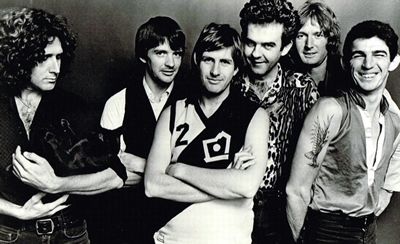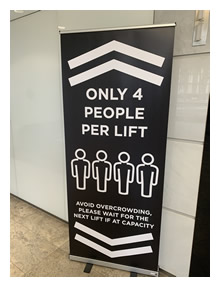
Half Time at the Football
Dave Warner from the Suburbs was the iconic front man for the band of the same name around the Perth pub scene blending biting social commentary with the theatrics of Johnny Leopard on guitar. His iconic song, Half Time at the Football analysed the everyday thoughts of players and spectators at the tipping point in the game.
ParkScience has dusted off the 1970 Gold Top and will endeavour to provide you with less biting, but hopefully reasoned and thoughtful commentary on the structural and cyclical changes that have been accelerated over the past year and where the Australian parking industry is placed as we enter 2021.
Work from Home – or a Home for Work?
This is shaping up as the most important structural change we will see in the engagement between employers and employees. Through December we saw surveys across the top ASX50 companies and CEO’s of large employer groups. The predominant view – and one we support is that employees have embraced working from home and anticipate that flexible work practices will become the norm for the majority of CBD workers.
Westpac’s GM for HR Shared Services, Su Duffey, said the bank (which employs over 10,000 staff in Sydney) – planned to bring all teams back to corporate offices for part of each week from early 2021, but some days would remain work from so the benefits of remote working weren’t lost.
Most likely this will take the form of working from home on Mondays and Fridays with collaborative office work in between. Looking at the Transport NSW databases on traffic volumes, this is already taking shape. As workers return to the CBD through February, post school holidays we will have a better understanding of the extent of this change.
The Office
 Samuel Clemens famous quote - “The report on my death was an exaggeration” – could well apply to the commercial office sector.
Samuel Clemens famous quote - “The report on my death was an exaggeration” – could well apply to the commercial office sector.
At the heart of good businesses are people – and for the human element to thrive and propel business forward requires various forms of personal interaction. Some of this is structured and some is random, unstructured, and spontaneous. Zoom and conference calls cannot achieve this.
However, within the commercial office sector we are likely to see a greater rental and occupancy gap between premium grade, iconic buildings and lesser stock. A good indication of this is industry leader DEXUS having already sold a number of slightly lower grade commercial office buidings at or above book value. Technology will be a factor here with air conditioning systems, lifts and more flexible offerings for tenants in the better buildings. If Monday and Friday are work from home days for substantial parts of the business you will need more flexible leasing arrangements – perhaps a combination of a fixed amount of space and variable short term co working space within the same building.
The other long term structural change has been the steady decline of businesses entering into long term parking licences/leases for employees. This has been a slow decline for well over a decade but has been accelerated by COVID as flexibility becomes key.
Public Transport
We have now seen NSW implement face masks on all public transport, which was already perceived by commuters as a far riskier form of transport than the car. Demand for all day parking products has seen a substantial increase, especially from Tuesday to Thursday. Digital products are the core driver. The prevalence of digital products will continue to increase, as will more flexible products.
Volumes across the NSW public transport network are down 66% compared to the same time last year.
Is this a cyclical trend that will revert when the vaccines are rolled out in Australia over the next 12 months?
Parking
The casual observer looking at centrally located carparks will see Tuesday to Thursday occupancies at a lot of sites at pre COVID levels and surmise the revenue streams could not be that different.
Occupancy is only one part of revenue – the other ingredient is yield.
Think of it like the Perth to Sydney QF flight pre COVID. A mix of 35% business and 65% economy class seats. The business class seats were four to five time the price of an economy seat. The plane was full.
The plane is now full three of five weekdays, but it has 5% business class seats and 95% economy class seats. And the night and weekend flights are less than 50% full.
Previous newsletters have talked about the substantial rent reversions taking place. Owners are entering into short term deals to allow the market to return to some form of normality. For the vast majority of carparks, it will not occur in this calendar year and for a significant number of sites will likely take years. And Levy in Melbourne is another problem – as there are no concessions for vacancies (which are close to 90% across most sites) beyond a 25% reduction for 2020.
Renewed COVID outbreaks in Melbourne,Sydney and Brisbane will further disrupt the return to office and it will be interesting to see how the Melbourne mandate of masks in the office impacts the trend.
As the office market becomes more fragmented so will carparks. Large multi decks and secondary located sites will feel the greatest pain.
We are seeing more management agreements in commercial carparks as some owners take a view that there is only upside in the market, so better to take it all, gather data on trade rather than enter into a lease. This will be a cyclical trend. Management agreements are best suited to sites where rate control/parker control/flexibility is required.
Will structural change take the form of owners moving to an in house model, which was prevalent over 20 years ago with Lend Lease, Mirvac , Hooker (remember them!) Leighton and Hindmarsh all taking this path, only to either sell or outsource at a later date? It is a possibility, however, the same fundamental problems arise with the parking business being subservient to the property business and compounded by the challenge and efficiencies of scale as the digital consumer will not look beyond page one of a google search for their parking requirements.
With most carparks unmanned, the cost of the control room and customer support staff are a substantial, and potentially vulnerable expense. ParkScience strongly advises these functions do not get moved to offshore locations or get combined with other large call centres as a cost saving measure. The loss of revenue either through leakage, lack of local knowledge and conditions or uneven levels of communications will outweigh any cost savings. Each carpark is fundamentally different to the next – even if they are in close physical proximity.
Parking is a revenue business – if the answer is not cutting costs to the bone, what is it?
Productivity
“Productivity isn’t everything, but in the long run, it is almost everything”
(Krugman, 1977)
For operators, productivity will come in a range of disguises from innovation through technology to operational techniques and the depth and knowledge of its management team.
This is not an “unknown unknown”, but a known known.